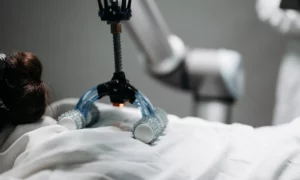In the dynamic world of healthcare, robotics is paving the way for revolutionary advancements, reshaping the landscape of medical surgeries and treatments. This innovative intersection between technology and medicine opens up new scopes, offering precise, efficient, and potentially transformative solutions to complex health challenges.
The role of robotics in surgeries is particularly noteworthy, providing unparalleled accuracy and reducing recovery times. These technological wonders assist surgeons in performing complex procedures with minimal interference, signaling a new era where patient care and surgical outcomes are significantly improved.
Beyond surgeries, robotics in healthcare extends to patient rehabilitation, diagnostics, and personalized care, highlighting the versatility and potential of robotic applications. As we look forward, the integration of robotics in healthcare promises not only to enhance clinical practices but also to inspire new levels of innovation, ultimately leading to better health outcomes and enriched patient experiences.
Applications Of Robotics In Healthcare
Robotic innovations are transforming healthcare across the USA, as seen through the pioneering work of several development companies, especially from an app development company in Texas. These innovations are introducing fresh possibilities that elevate patient care, enhance outcomes, and streamline medical processes with unmatched accuracy. From operating rooms to patient homes, robotics is reshaping how healthcare is delivered, promising a future where medicine is more accessible, less invasive, and highly personalized.
- Surgery and Minimally Invasive Procedures: Robotics provide surgeons with unparalleled precision, allowing for minimally invasive surgeries that reduce recovery time and improve outcomes.
- Rehabilitation and Physical Therapy: Robots assist in recovery, offering personalized therapy sessions that adapt to the patient’s progress and needs.
- Telemedicine and Remote Care: Robotic systems enable healthcare professionals to provide care remotely, breaking down geographical barriers to healthcare access.
- Diagnostic Imaging and Radiology: Automation in imaging leads to quicker, more accurate diagnoses, enhancing patient care through technology.
- Laboratory Automation: Robotics streamline lab processes, improving medical testing and research efficiency and reliability.
- Pharmacy and Medication Management: Automated systems ensure precise medication dispensing, reducing errors and improving patient safety.
- Patient Assistance and Elderly Care: Robots provide support and companionship, improving the quality of life for elderly and physically challenged patients.
- Emergency Response and Disaster Management: In critical situations, robots can go where humans can’t, providing life-saving interventions and support.
- Drug Delivery: Advanced robotics enable targeted drug delivery, maximizing therapeutic effects while minimizing side effects.
- Patient Monitoring: Continuous, automated monitoring allows for early detection of health changes, ensuring timely intervention.
As we adopt these applications, the potential for robotics in healthcare continues to expand, promising a future where technology and human care converge to offer the best possible outcomes for patients.
Different Types Of Robots Being Used In Healthcare Industry
In the heart of healthcare’s evolution, robots are playing pivotal roles, shaping a future where precision, efficiency, and compassion meet. The healthcare industry is witnessing a remarkable integration of robotic technology, each type designed to enhance patient care, streamline processes, and offer solutions previously unimagined. From assisting in complex surgeries to providing companionship, these machines are redefining what it means to deliver healthcare.
- Surgical Robotics: These robots are transforming the operating room, offering surgeons unprecedented precision and control. They allow for minimally invasive procedures, reducing patient recovery time and improving surgical outcomes. Surgical robots are becoming indispensable tools, providing a level of dexterity and visualization that enhances the surgeon’s capabilities.
- Radiotherapy Robots: Revolutionizing cancer treatment, these robots deliver precise doses of radiation with incredible accuracy. They’re designed to target tumors with minimal impact on surrounding healthy tissues, improving treatment effectiveness and patient comfort. Radiotherapy robots are a testament to the innovative approaches being applied in the battle against cancer.
- Laboratory Robots: In the realm of diagnostics and research, laboratory robots are streamlining processes and enhancing accuracy. These automated assistants handle tasks with speed and precision, from analyzing samples to managing data, thereby increasing lab productivity and reducing human error.
- Hospital Service Robots: Addressing logistical needs within healthcare facilities, these robots assist with everything from delivering medications and meals to sanitizing rooms. They play a crucial role in improving hospital efficiency and reducing the risk of infection, showcasing the diverse applications of robotics beyond direct patient care.
- Social Robots: These robots offer social interaction and support, particularly for patients who are elderly or children. By engaging in conversations and activities, they provide emotional comfort and companionship, demonstrating the softer side of robotic technology in healthcare.
As robots become more integrated into healthcare, they not only complement the human touch but also extend the boundaries of what medical professionals can achieve. This synergy between human care and robotic precision is ushering in a new era of healthcare, where every patient benefits from the advancements of technology.
Benefits Of Robotics In Healthcare
Robotics in healthcare is ushering in a transformative era, elevating patient care, streamlining operational efficiency, and ensuring safety in medical environments. This technological evolution promises not just advancements in medical procedures but also a fundamental shift in the way care is delivered, blending innovation with compassion to meet the complex needs of today’s healthcare challenges.
- Enhanced Patient Care: Robotics in healthcare contribute significantly to improved patient outcomes. By facilitating minimally interfering surgeries, offering precise diagnostic capabilities, and providing personalized rehabilitation programs, robots are delivering high-quality care. They enable less painful treatments, reduce recovery times, and increase the overall effectiveness of healthcare services.
- Efficiency in Clinical Operations: The integration of robotics streamlines various clinical processes, from surgery to patient monitoring. These technological aids automate routine tasks, reduce the time spent on administrative duties, and help in managing resources more effectively. As a result, healthcare professionals can focus more on patient care, leveraging robots for logistical support and operational efficiency.
- A Safer Healthcare Environment: Robotics play a crucial role in maintaining and improving safety standards within healthcare facilities. From disinfecting patient areas to handling hazardous materials, robots minimize the risk of infections and ensure a cleaner, safer environment for patients and healthcare workers. This not only enhances the quality of care but also protects those at the heart of healthcare delivery from unnecessary risks.
Through these benefits, robotics in healthcare not only promise a future where medical care is more accessible, personalized, and effective but also where healthcare professionals can engage more deeply with the art of healing, supported by the precision and reliability of technology.
Challenges And Considerations of Implementing Robotics in Healthcare
Integrating robotics into healthcare heralds a future of unparalleled precision and personalization in patient care. Yet, this journey has challenges and considerations that must be thoughtfully navigated. Addressing these hurdles is crucial for unlocking the full potential of robotics in transforming healthcare delivery and outcomes.
- Initial Implementation Costs: The financial investment required to integrate robotics into healthcare settings is significant. These costs include purchasing the robots, setting up the necessary infrastructure, and adapting existing systems and processes to accommodate the new technology.
- Training and Skill Development: Implementing robotics demands a workforce skilled in technology and robotics. Healthcare professionals must undergo specialized training to effectively utilize these advanced tools, ensuring they enhance rather than complicate care delivery.
- Ethical and Legal Concerns: The use of robotics raises important ethical and legal questions, from patient privacy to liability in case of malfunctions. Navigating these issues requires careful consideration and robust regulatory frameworks.
- Patient Acceptance and Trust: Gaining the trust of patients is paramount. It involves demonstrating the safety, effectiveness, and benefits of robotic interventions, ensuring patients are comfortable and confident in receiving care facilitated by robots.
Overcoming these challenges is essential for harnessing the complete power of robotics in healthcare, ensuring that both providers and patients alike can fully benefit from these technological advancements.
A few case studies that prove the successful utilization of robotics in healthcare
The successful integration of robotics in healthcare is not just a prediction for the future; it’s happening now, with numerous case studies across the globe showcasing the transformative power of these technologies. From enhancing surgical precision to providing compassionate care, robotics is making significant strides in improving patient outcomes and operational efficiency.
Let’s explore three illustrative case studies highlighting the diverse and impactful robotics applications in healthcare.
- Japan’s Therapeutic Robots: In Japan, robotics has made a heartfelt impact, particularly with PARO, a therapeutic robot designed to provide companionship and emotional support to elderly patients and those with dementia. This innovation demonstrates how robots can extend beyond physical tasks, touching lives through emotional engagement and support.
- Singapore’s Hospital Automation: Singapore has embraced robotics to streamline hospital operations, notably with the Handle robot, which autonomously transports patients and equipment. This application underscores robotics’ potential to enhance logistical efficiency and safety within healthcare facilities, showcasing a forward-thinking approach to hospital management.
- The United States Surgical Precision: The United States has seen the adoption of the da Vinci Surgical System, a robot that assists in performing minimally invasive surgeries with extraordinary precision. This case study highlights how robotics can significantly improve surgical outcomes, reduce recovery times, and revolutionize patient care in the operating room.
These examples provide a glimpse into the future of healthcare, where robotics plays a central role in delivering care that is not only more efficient and effective but also more humane and patient-focused.
Conclusion
Across the USA, the journey of robotics in healthcare showcases not just technological innovation, but a major shift towards more personalized, efficient, and compassionate patient care. Through cutting-edge healthcare services, especially with the health app development services in Texas, we’re witnessing a transformative era where robotics seamlessly integrates into the healthcare ecosystem.
Several App development companies in the USA stand at the forefront of this revolution, crafting solutions that embody precision and innovation. As we look towards a future enriched by these advancements, the promise of robotics in healthcare is certainly bright, setting a new standard for excellence in patient care and operational efficiency.
Read more from techbullion



































